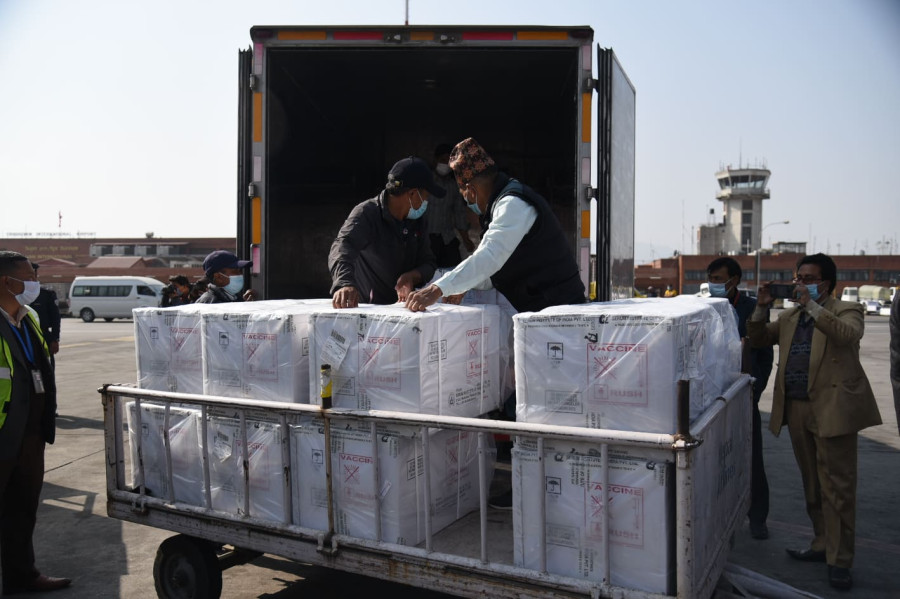Health
Government crunching numbers to make vaccination drive effective
With the arrival of the second consignment of million doses, officials likely to request WHO to delay the shipment of vaccines under COVAX programme.
Arjun Poudel
When the government rolled out the Covid-19 vaccination drive throughout the country on January 27, two doses of the vaccine was wasted at Sukraraj Tropical and Infectious Disease Hospital, the first to start the immunisation campaign.
As only selected health workers called for immunisation, and all invitees did not take the jab, immunisation workers had to discard two doses. “We had to discard two doses of the vaccine on the first day,” Dr Sagar Rajbhandari, director at the hospital, told the Post. “Then I directed my staffers to use the jabs prudently to avoid wastage.”
Public health experts are calling on the government to devise proper plans to ensure that available vaccine doses are not wasted and people are inoculated ahead of a potential second wave of infections already being observed in India.
The Ministry of Health and Population has been preparing to start the second phase of immunisation from March 7. “We have sufficient doses for the second phase of immunisation,” Dr Bhim Sing Tinkari, director at the Management Division under the Department of Health Services, told the Post
Of the one million doses provided by India under grant assistance, around 400,000 doses have been administered so far. The remaining doses are set to expire on April 13.
Apart from this, the government has ordered two million doses of Covishield vaccine from the Serum Institute of India, which produces vaccines developed by the University of Oxford and pharmaceutical giant AstraZeneca. The first consignment of a million doses arrived in Kathmandu on Sunday and the remaining one million is to arrive within a week.
Unlike other regular vaccines, which can be used within 18 months of production, coronavirus vaccines have to be used within six months. But officials say that in reality, they just have four to five months administer the vaccine once it lands in Kathmandu.
Tinkari said that the health Ministry currently does not have any plans to procure additional doses unless the available doses are used. He said that the government is likely to request the World Health Organization’s COVAX programme to provide vaccines to Nepal only when it needs it.
“We are thinking of requesting the World Health Organization to supply COVAX jabs only when we need them.” Authorities are expecting the World Health Organization’s COVAX facility to provide 2.25 million doses of Covishield to Nepal in the first phase.
With proper plans needed to make use of all the doses available, experts say the officials must take decisions carefully. “What is more worrying is that the expiry date of the remaining doses of the vaccine is nearing, and we are faced with the possibility of a second wave of infection,” Dr GD Thakur, former director at the Epidemiology and Disease Control Division, told the Post.
“We should not forget that after a consistent decline in new cases in India, numbers have picked up in at least four states of India again due to new variants of the virus.”
According to Times of India, the number of coronavirus cases in India is surging, particularly in Punjab, Maharashtra, Kerala and in Madhya Pradesh.
The rise in the number of cases was reported amidst the discovery of several new variants of Covid-19, which is said to be more transmissible than the prevailing variants.
The government had started the first phase of immunisation using one million doses of vaccine provided by India under grant assistance. In the first round 430,000 front line workers, including health workers, supporting staff, ambulance drivers, female community health volunteers, security personnel deployed for managing the bodies of Covid-19 victims, people residing in old age homes and prisoners, were in the priority list.
In a scramble to utilise the precious grant, the ministry then decided to inoculate journalists in Kathmandu Valley and those working in diplomatic missions. The number of those immunised under the new arrangement stood at some 20,000. Employees of financial institutions, staff at local governments and their elected representatives were chosen to be immunised later. Their numbers were estimated to be at 300,000.
Tinkari concedes that using the available doses of vaccine has become a challenge due to the slow pace of immunisation.
“We will use the remaining doses provided by India under grant assistance first and then only open the new batch of vaccines we purchased,” he added.
Experts are also saying that the government needs to step up the whole process to include as many people as possible. “We should use all our strength to speed up the immunisation process,” Dr Janak Koirala, an infectious disease expert, told the Post. “We should not forget that we have to immunise a large number of people and the risk of a new wave of infection is not over.”
Doctors, however, cautioned that vaccine doses should not be wasted in the name of speeding up the immunisation drive. They said that even if the wastage was minimal in the first phase of drive, it will increase when the programme is extended to the community level.
“Health workers should be asked to try their best to not discard the vaccine, and immunise vulnerable people if some doses are left after opening a vial,” Tinkari, director at the management Division, added.
Doctors say, once a vial is opened, it can’t be administered after six hours. Each vial consists of 10 doses, and health workers have to open the vial when eight or nine people come seeking immunisation.
Generally around 10 percent of doses go waste in mass immunization campaigns. “But we had less than five percent wastage in the first phase,” an official at the department, told the Post.




 18.12°C Kathmandu
18.12°C Kathmandu














